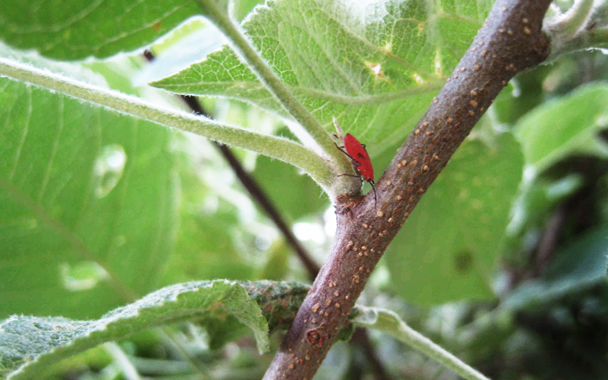If anyone had told me a couple of years ago that I’d be doting on a row of potato plants and defending them by picking flea beetles from their deep green leaves and unceremoniously squishing them with my bare hands, I would have said, “Have another drink.” But here we are, Stephen and I, picking, cursing, squishing, then spotting a yellow striped cucumber beetle and sending him on to the next life. Potatoes and eggplant are what flea beetles live for, but, I learned this week from a horticulture pro, planting these crops (part of the nightshade family) is not necessarily like issuing an all-access pass for bugs. If you practice Integrated Pest Management (IPM) techniques (one of which is hand picking), it can be like having a velvet rope and a burly bouncer at your garden gate.
As a Master Gardener, Stephen spends time volunteering in the Cornell University Cooperative Extension lab, helping to diagnose disease and pest problems from samples gardeners bring in. He was in the process of identifying a little red bug (which turned out to be a boxelder) that was making a nuisance of itself in a fruiting apple tree, and I tagged along for a crash course in IPM with Jennifer Stengle, one of the Extension’s environmental horticulture educators.
When I arrive, Stengle is admiring a pair of very large, very long-antennaed beetles affixed with florist’s pins to a piece of white cardboard. “Someone brought them in thinking they were Asian longhorned beetles,” she says, “but these guys are white-spotted sawyers”—a relief to anyone who has seen a stand of maple trees decimated by longhorns.
As our talk moves from Asian longhorns to flea beetles, Stengle lays out the four-fold process of IPM, which includes cultural, biological, physical, and chemical controls. Cultural controls have to do with the way you plant and care for your garden; for example, before you even plant anything, “It’s important to know your enemy,” Stengle says. “When you make plant choices, be aware of which bugs will prey on them. Do your homework.” (In community gardens, of course, your neighbor’s plant choices become yours, as the pests hop from plot to plot.) She also offers a valuable tip for preventing disease from the get-go: Examine plants thoroughly before putting them in the soil, remove pest-damaged plants, and clean up and discard diseased plant parts (don’t compost them). Biological controls are living organisms—including beneficial insects like lady beetles and microbial insecticides such as the natural bacteria Bacillus thuringiensis (BT)—that kill harmful bugs. Physical controls are methods of keeping pests away or removing them from your plants (like the hand removal that Stephen and I have been doing). And chemical controls should be used only as a last resort; some environmentally friendly chemical options include insecticidal soaps (which contain sodium or potassium salts combined with fatty acids) and neem oil (extracted from the seeds of the neem tree fruit), which helps to halt the maturation of certain pests. Check out Cornell’s Eco-gardening fact sheets or its Resource Guide for Organic Insect and Disease Management for more detailed info on these IPM principles.
If you’re having trouble identifying problem pests on your own, take the bug or samples of the plant (from both the affected portion and the healthy parts) to your local Extension office. If it’s a hard-bodied bug it can be frozen; and if it’s soft-bodied, put it in a bit of rubbing alcohol and place it in a tightly closed plastic container or bag. Stengle laughs as she tells me this, opening her lab refrigerator to show me a salami sitting among the plants and the insects in containers. “Tightly is the operative word.”



 Pinterest
Pinterest


